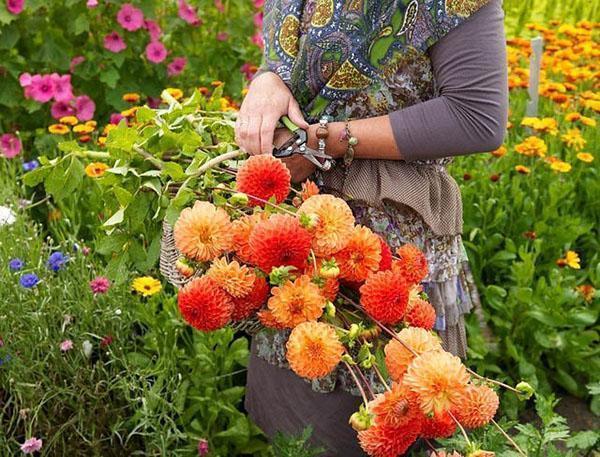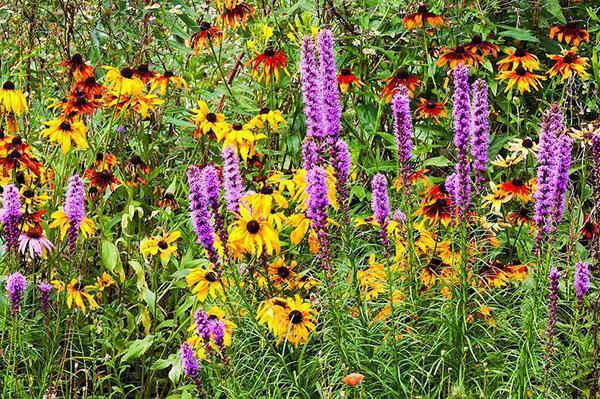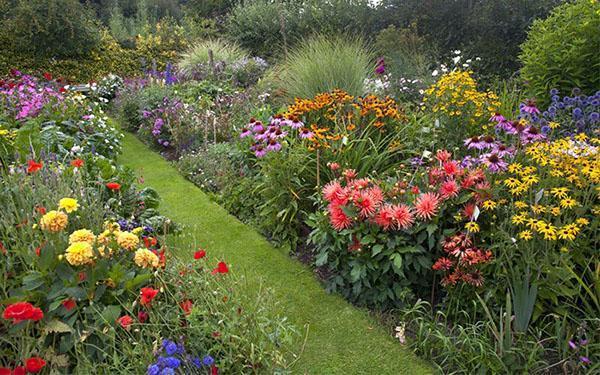The August cares of the gardener in the flower beds
 In August, summer cottages are especially beautiful. Summer seems to be gathering strength to stun perennials with fireworks in its last month: dahlias and gladioli, phlox and clematis. Letniki bloom no less magnificently: godetia and sweet peas, petunias, marigolds, calendula and zinnias.
In August, summer cottages are especially beautiful. Summer seems to be gathering strength to stun perennials with fireworks in its last month: dahlias and gladioli, phlox and clematis. Letniki bloom no less magnificently: godetia and sweet peas, petunias, marigolds, calendula and zinnias.
But it is impossible to maintain the brightness and freshness of flower beds, curbs and slides if you neglect regular maintenance. The main tasks of a grower in August are:
- pruning faded flowers and dried flower stalks;
- removal of weeds;
- feeding perennial crops;
- planting seedlings of perennials to a permanent place;
- watering.
For summer residents who are keen on ornamental plants, such daily chores can take a lot of time, but they cannot be done without them. But besides this, the final summer of August is the best time to start blooming next year. At the end of summer and in the first days of autumn, perennials are sown, adults, rhizome and bulbous plants are planted and divided, and places for planting shrubs are prepared. find out about coreopsis in our next article!
Maintenance of summer cottages in August

If the summer resident does not have the opportunity to water the flower beds in the heat, it is better to plant the most drought-resistant crops on them, for example, purslane, stock roses and zebrin mallow, gypsophila, cosmea, coreopsis.
After glazewhen the soil is pliable, weeding and loosening are especially convenient. In August, many annuals complete their growing season and can be removed to make room for new crops. In perennials, dried peduncles, dead stems and leaves are regularly cut off. To support the formation of buds and help the flowers prepare for the cold weather, biennials and perennials are fed in August potassium-phosphorus compositions... Gladioli and dahlias overwintering outside the ground, as well as ornamental shrubs growing on the site, will respond well to such feeding.
For summer residents who prefer to take care of the seed themselves, in August it is time to collect the seeds of nasturtium and levkoi, coreopsis, carnations and various types of bells, as well as bright godetia and mallow from the flower beds.
 In mid-August, there comes a time when the nights get too cold and the houseplants taken out into the garden should be returned to the room. So that all plants in the house are not attacked by aphids, spider mites, trips and other pests, it is useful to arrange a small quarantine for begonias, pelargoniums, hypeastrum and other species returning from the garden.
In mid-August, there comes a time when the nights get too cold and the houseplants taken out into the garden should be returned to the room. So that all plants in the house are not attacked by aphids, spider mites, trips and other pests, it is useful to arrange a small quarantine for begonias, pelargoniums, hypeastrum and other species returning from the garden.
August: time to propagate and plant perennials in a flower bed
 August, as well as possible, is suitable for the renewal and expansion of plantings of primroses, perennial oriental poppies, lilies of the valley, bathers, peonies and lilies. In the first half of the month, adult clumps of primroses are divided. In the garden, these flowers can grow without transplanting for up to 5 years, then the flowering weakens or even fades away. In a new place, 20-30 cm is left between the seedlings so that the primroses will grow freely next spring.
August, as well as possible, is suitable for the renewal and expansion of plantings of primroses, perennial oriental poppies, lilies of the valley, bathers, peonies and lilies. In the first half of the month, adult clumps of primroses are divided. In the garden, these flowers can grow without transplanting for up to 5 years, then the flowering weakens or even fades away. In a new place, 20-30 cm is left between the seedlings so that the primroses will grow freely next spring.
Clumps of perennial poppies grow by the end of summer.Young plants can be planted at this time of the year. If you delay, the roots will lengthen and the transplant will become more difficult.
Poppies thrive in open areas, they are undemanding to soil fertility and withstand drought perfectly. If you have to transplant a swimsuit, it is better to choose a place in partial shade, where the flowers last a little longer.
Peonies Are some of the most popular garden perennials. By August, their flowering ended long ago, and the summer resident knows for sure which bushes did not meet expectations and require transplantation. This is done with old plants or flowers that have fallen to the wrong place. The bush is divided into parts with 2-3 buds and its own rhizome segment 15-20 cm long.
In August, perennial asters, phlox, garden chamomile and daylilies can be planted or re-planted. Plants sown on seedlings are transferred to a permanent place this month:
- violets;
- aquilegia;
- stock-roses;
- foxgloves;
- bells;
- nivyanik and other biennials and perennial crops.
 If there was no time to plant in the spring, it is not too late to sow these plants in August. In this case, the first flowers will appear a year later.
If there was no time to plant in the spring, it is not too late to sow these plants in August. In this case, the first flowers will appear a year later.
Reproduction and transplantation of perennials in August
In August, ornamental shrubs and trees require the attention of the summer resident. Hedges and curbs are cut, inflorescences are cut from faded plants.
 Green cuttings of spirea, mock orange and lilac, barberry and clematis, hydrangeas and forsythia, viburnum and many other popular shrubs will have time to take root at the end of summer. For this, the cut parts of the shoots are dropped into a light substrate. In the greenhouse, the cuttings form roots and the next year they will turn into young, quite viable bushes.
Green cuttings of spirea, mock orange and lilac, barberry and clematis, hydrangeas and forsythia, viburnum and many other popular shrubs will have time to take root at the end of summer. For this, the cut parts of the shoots are dropped into a light substrate. In the greenhouse, the cuttings form roots and the next year they will turn into young, quite viable bushes.
When choosing a place to plant a particular plant, you need to remember its preferences, for example:
- heathers, hydrangeas, conifers need an acidic soil;
- neutral soil is vital for lilacs, forsythia, chubushnik and cotoneaster, barberry and most other shrubs.
Sanitary pruning of shrubs on the eve of autumn should include not only the removal of old and dried shoots, but also pruning of root growth. It is especially important to remove shoots from grafted crops.